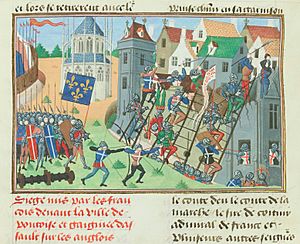Siege of Pontoise facts for kids
Quick facts for kids Siege of Pontoise |
|||||||
|---|---|---|---|---|---|---|---|
| Part of the Hundred Years' War | |||||||
 Illumination adorning La Cronicque du temps de Tres Chrestien Roy Charles, septisme de ce nom, roy de France by Jean Chartier, c. 1470–1479 |
|||||||
|
|||||||
| Belligerents | |||||||
| Commanders and leaders | |||||||
|
Garrison: Relief armies: John Talbot |
|||||||
| Strength | |||||||
| 5,000 | Garrison: 1,000–1,200 Relief army: 3,600 |
||||||
| Casualties and losses | |||||||
| 400–500 killed Hundreds captured Unransomed captives killed |
|||||||
The Siege of Pontoise was an important battle during the Hundred Years' War. It happened from June 6 to September 19, 1441. French forces, led by King Charles VII of France, surrounded and captured the town of Pontoise. This victory removed the last English stronghold in the Île de France region, which protected Paris from English attacks.
Contents
Preparing for the Siege
French Army Gathers
In 1441, King Charles VII of France prepared a large army. He gathered about 5,000 soldiers. The army was led by the King himself and Arthur de Richemont, who was a top military leader called a Constable.
Powerful French Artillery
The French army also brought many powerful cannons. These cannons were led by Jean Bureau, a skilled artillery expert. Their first target was the town and castle of Creil.
Capture of Creil
The French army attacked Creil on May 8. Their cannons were so strong that they broke through the town's walls. The English soldiers defending Creil, led by William Peyto, surrendered on May 25. This victory showed the power of the French army and its cannons.
The Siege of Pontoise Begins
Surrounding Pontoise
After Creil, King Charles VII set his sights on Pontoise. The town had an English army of 1,000 to 1,200 soldiers. The French began their attack on June 6.
Cutting Off Supplies
Before the siege, French soldiers from Louviers had built a fort on the Seine river. This fort helped stop supplies from reaching Pontoise from Rouen. However, the English commander, John Talbot, had already sent many supplies and cannons to Pontoise since mid-May.
French Headquarters and Advance
King Charles VII set up his main base at Maubuisson Abbey. A French commander named Prigent VII de Coëtivy built a special floating bridge across the Oise river. This allowed French troops to capture the Abbey of Saint-Martin, which was just outside Pontoise's walls.
Cannon Attacks on the Town
Jean Bureau's powerful cannons then focused on the "barbican," a strong outer defense at the end of the town bridge. They fired for 15 days until the French captured it. After that, the cannons were moved and began firing directly into the town of Pontoise.
English Attempts to Help Pontoise
Talbot's Relief Efforts
From June 16 to September 5, the English commander John Talbot tried to help Pontoise five times. He sent soldiers and supplies into the town through a gate on the river side. King Charles had told his Constable not to fight Talbot directly during these attempts.
York's Arrival and Skirmishes
In mid-July, another English army arrived. This force had 900 knights and 2,700 archers, led by Richard, Duke of York. Talbot also launched a fake attack to distract the French. But the French stayed in their strong positions and did not leave the siege.
York's Retreat
Duke Richard of York fought some small battles with the French. He tried to stop supplies from reaching the French army from Paris. However, York's own army started running out of supplies. In mid-August, he had to pull back and return to Normandy.
Final Attack and French Victory
Renewed Bombardment
After Duke York left, King Charles VII started the siege again on August 16. The French cannons continued to pound the town walls.
Storming the Walls
On September 16, French soldiers, led by de Lohéac and de Bueil, found a weak spot in the wall. They stormed through this opening and captured the church of Notre Dame inside the town. They defeated 30 English defenders, killing 24 of them.
Pontoise Falls
On September 19, the French launched a full attack on Pontoise. The English soldiers defending the town were completely defeated. Between 400 and 500 English soldiers were killed, and hundreds more were captured. This included the English commander, Lord Clinton. The French had very few losses.
Aftermath of the Siege
Fate of the Town and Prisoners
Because Pontoise was captured by a direct attack, not by surrender, the people of the town were at the mercy of King Charles. All their property was taken. Lord Clinton and most of his officers were later set free after their families paid a ransom. However, those English soldiers who could not pay a ransom were sadly drowned in public.
End of English Control
The capture of Pontoise meant that the English had lost their last strong base in the Île de France region. This was a major victory for France in the Hundred Years' War.

